List of Contents
Robotic Vial Washing and Filling Machines Market Size and Forecast 2025 to 2034
The global robotic vial washing and filling machines market size accounted for USD 562.94 million in 2024 and is predicted to increase from USD 587.82 million in 2025 to approximately USD 867.56 million by 2034, expanding at a CAGR of 4.42% from 2025 to 2034. The market is witnessing rapid growth because of the increasing demand for automation in pharmaceutical manufacturing, driven by the rising production of injectable drugs, and the rising need for advanced aseptic processing technologies.
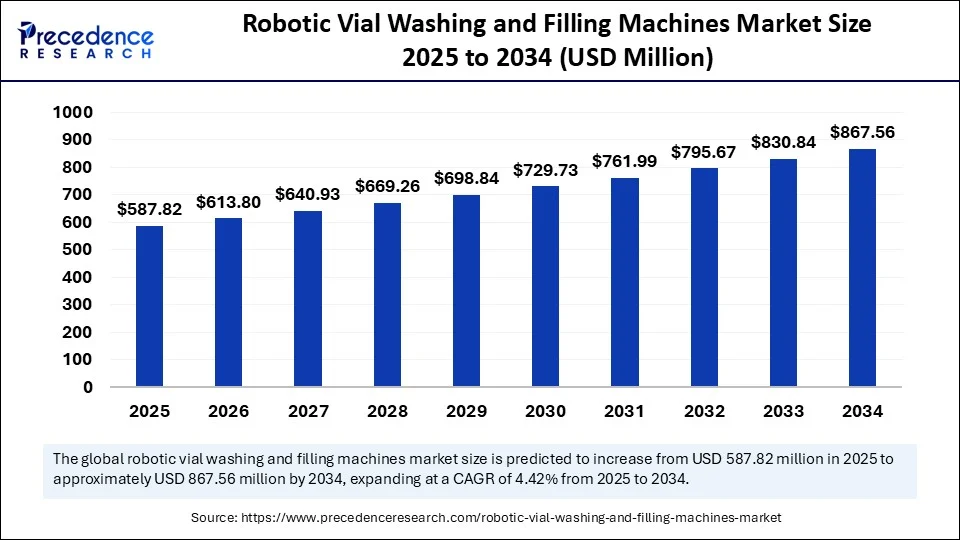
Robotic Vial Washing and Filling Machines MarketKey Takeaways
- In terms of revenue, the robotic vial washing and filling machines market was valued at USD 562.94 million in 2024.
- It is projected to reach USD 867.56 million by 2034.
- The market is expected to grow at a CAGR of 4.42% from 2025 to 2034.
- North America generated the largest market share of 36% in 2024.
- Asia Pacific region is expected to grow at the highest CAGR from 2025 to 2034.
- By machine type, the robotic vial washers segment held the major market share of 51% in 2024.
- By machine type, the robotic vial filling machines segment is expected to grow at a significant CAGR over the projected period.
- By type, the standalone washing machines segment held the biggest market share in 2024.
- By type, the standalone filling machines segment is expected to expand at a significant CAGR in the upcoming period.
- By application type, the vaccines segment contributed the biggest market share in 2024.
- By application type, the small molecule drugs segment is expected to grow at a significant CAGR during the forecast period.
- By end-user, the pharmaceutical & biopharmaceuticals companies segment held the major market share in 2024.
- By end-user, the CMOs & CDMOs segment is expected to grow at a considerable CAGR between 2025 and 2034.
How is AI Influencing the Robotic Vial Washing and Filling Machines Market?
Artificial intelligence (AI) is transforming the robotic vial washing and filling machines market by enhancing efficiency, lowering costs, and improving quality control. AI-powered systems can monitor processes in real time, predict potential equipment failures, and optimize performance, leading to less downtime and increased throughput. These systems can automatically adapt to various vial sizes, product viscosities, and filling requirements, reducing the time and effort needed for changeovers. Additionally, AI-powered machine vision systems can detect defects in vials, like cracks and contamination, with greater accuracy and speed than human operators.
U.S. Robotic Vial Washing and Filling Machines Market Size and Growth 2025 to 2034
The U.S. robotic vial washing and filling machines market size was exhibited at USD 154.02 million in 2024 and is projected to be worth around USD 242.24 million by 2034, growing at a CAGR of 4.63% from 2025 to 2034.
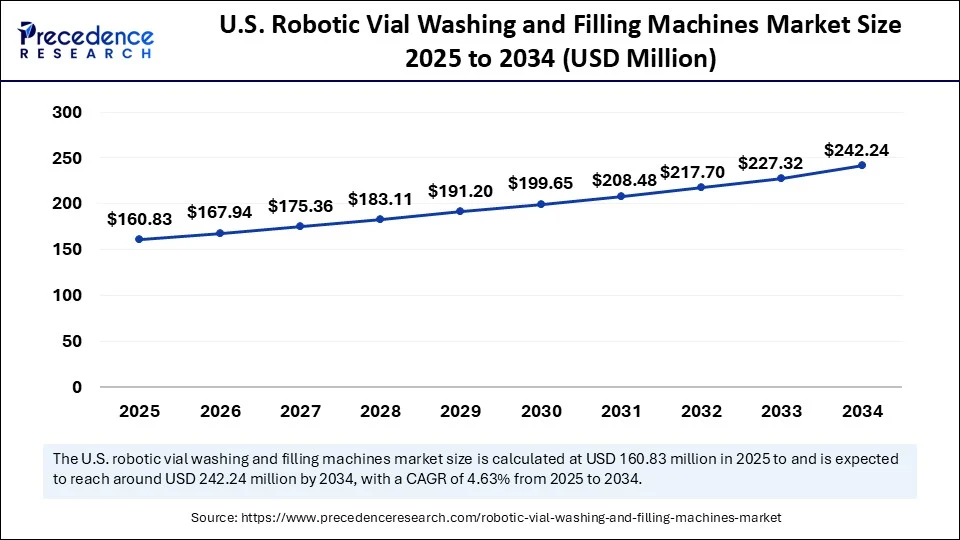
What Made North America the Dominant Region in the Robotic Vial Washing and Filling Machines Market in 2024?
North America dominated the market for robotic vial washing and filling machines, capturing the largest market share of 36% in 2024. This is primarily due to its well-established pharmaceutical and biopharmaceutical industries, supportive government policies, and a high adoption rate of automation. The presence of major pharmaceutical and biopharmaceutical companies in North America, such as Johnson & Johnson, AbbVie, Pfizer, Merck & Co., and Bristol Myers Squibb, drives the demand for advanced automation solutions like robotic vial washing and filling machines. The region also benefits from substantial investments in manufacturing automation and a focus on clean and efficient filling technologies, which further incentivize the adoption of automation technologies and foster a favorable environment for market growth.
The U.S. Robotic Vial Washing and Filling Machines Market Trends
The U.S. plays a major role in the market for robotic vial washing and filling machines within North America. The country is home to some of the leading pharmaceutical and biopharmaceutical companies and CDMOs. Supportive government policies that promote innovation in the life sciences sector further support market expansion. These robotic systems are transforming pharmaceutical manufacturing by enhancing efficiency, reducing human error, and ensuring consistent product quality.
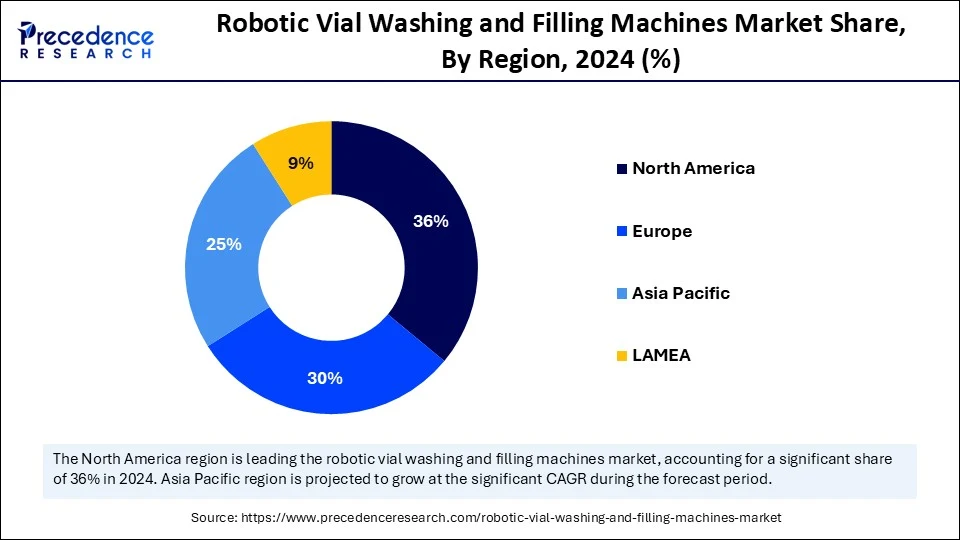
What are the Major Trends in the Robotic Vial Washing and Filling Machines Market Within Asia Pacific?
Asia Pacific is expected to expand at the fastest CAGR in the coming years due to the rapid expansion of the pharmaceutical industry, driven by increasing healthcare expenditure, the rising prevalence of chronic diseases, and a growing focus on drug development. This growth necessitates increased production capacity and efficiency, making robotic vial washing and filling machines highly appealing. Furthermore, increasing investments in automation and supportive government initiatives encourage the adoption of advanced technologies, streamline regulatory processes, and provide financial incentives for companies investing in automation. Many countries, such as China and India, are leading this growth due to their large domestic markets, increasing adoption of automation, and investments in infrastructure development.
China Robotic Vial Washing and Filling Machines Market Trends
China plays a vital role in the market for robotic vial washing and filling machines. The expanding pharmaceutical sector and increased investments in domestic and multinational pharmaceutical companies heightened the demand for these machines. China is also expected to be a major growth area within the Asia-Pacific region, which itself is experiencing rapid expansion in this market to meet rising healthcare needs and increasing demand for drugs.
India Robotic Vial Washing and Filling Machines Market Trends
India is emerging as a major player in the market due to the growing need to automate pharmaceutical manufacturing to boost production. The expanding pharmaceutical industry and government investments to modernize healthcare infrastructure are boosting the demand for automated solutions. Additionally, India's pharmaceutical companies are investing in automation to enhance production efficiency and comply with stringent regulatory standards.
Why is Europe Considered a Notable Region in the Robotic Vial Washing and Filling Machines Market?
Europe is anticipated to grow at a considerable rate in the upcoming period, driven by a strong pharmaceutical industry, rigorous regulations, and an emphasis on automation. The presence of major pharmaceutical companies and a push for advanced manufacturing technologies spur the demand for these machines. European countries like Germany, Switzerland, and the UK are home to numerous pharmaceutical giants that drive the demand for high-precision and automated solutions in vial handling. The European Union also supports collaborative research and innovation projects in areas such as automation, robotics, and digital technologies, which directly benefit the market for robotic vial washing and filling machines.
Market Overview
Robotic vial washing and filling machines are automated systems used in various industrial environments to clean, sterilize, and fill vials with liquids. These machines oversee the entire vial handling process, from washing and sterilization to filling and capping. They leverage robotic arms and integrated vision systems not only to facilitate precise handling and filling by reducing human intervention but also to mitigate contamination risks. These machines are engineered to comply with strict pharmaceutical regulations and standards, ensuring sterility of the final product while achieving faster processing speeds and thus enhancing overall production efficiency. The market is growing due to increased demand for injectable drugs, along with the push for enhanced automation in pharmaceutical manufacturing and a heightened focus on precision and sterility.
What are the Key Trends in the Robotic Vial Washing and Filling Machines Market?
- Emphasis on Automation and Robotics: The integration of robotics, AI, andmachine learning into these machines enables enhanced precision, speed, and efficiency in vial handling, filling, and sterilization. Pharmaceutical companies are also increasingly adopting automation to improve efficiency, reduce costs, and enhance product quality.
- Growing Demand for Injectable Drugs: The increasing prevalence of chronic diseases, together with an aging population and the rise in biologics, are further driving the demand for injectable medications, which in turn fuels the demand for efficient and reliable vial filling and washing processes.
- Focus on Sterility and Product Quality: These machines are designed to minimize contamination risks and ensure the highest levels of sterility during the vial washing and filling processes, which is critical for drug safety and efficacy, driving the market growth.
- Affordability and Efficiency: By automating these processes, manufacturers are able to minimize labor costs with enhanced production speed and reduced waste, resulting in overall cost savings and boosted operational efficiency.
- Stringent Regulatory Compliance: Stringent regulatory requirements and the demand to reduce human error and contamination are driving the adoption of robotic systems. The pharmaceutical industry is heavily regulated, with strict standards such as cGMP and 21 CFR Part 11, where systems help manufacturers meet these requirements by offering consistent and reliable processes.
Market Scope
| Report Coverage | Details |
| Market Size by 2034 | USD 867.56 Million |
| Market Size in 2025 | USD 587.82 Million |
| Market Size in 2024 | USD 562.94 Million |
| Market Growth Rate from 2025 to 2034 | CAGR of 4.42% |
| Dominating Region | North America |
| Fastest Growing Region | Asia Pacific |
| Base Year | 2024 |
| Forecast Period | 2025 to 2034 |
| Segments Covered | Authentication, Component,Deployment, Application, and Region |
| Regions Covered | North America, Europe, Asia-Pacific, Latin America, and Middle East & Africa |
Market Dynamics
Drivers
Increasing Demand for Injectable Drugs
The primary driver of the robotic vial washing and filling machines market is the increasing demand for injectable drugs, specifically those used to treat chronic conditions such as diabetes, autoimmune disorders, and cancer. This heightened need necessitates larger production volumes of injectable medications, which subsequently increases the demand for automated vial processing equipment. Advancements in technology further propel the growth of the market. Innovations in automation and sterile technologies are enabling the development of next-generation vial washing and filling machines. Moreover, the growing emphasis on automation in pharmaceutical manufacturing is fueling the market's growth.
- In September 2024, Steriline showcased its new Robotic Vial Filling & Capping Machine (RVFCM11-S) at CPHI Milan. This innovative machine is poised to attract pharmaceutical professionals and companies eager to enhance production efficiency and maintain compliance with stringent industry standards specifically designed for the primary packaging of cell and gene therapies.
(Source: https://www.packagingstrategies.com)
Restraint
Higher Initial Investment and Maintenance Costs
The main restraint in the robotic vial washing and filling machines market is the higher initial investment and maintenance costs. This can pose a significant barrier, particularly for smaller and medium-sized pharmaceutical companies. The costs associated with purchasing and installing robotic vial washing and filling machines are considerable, encompassing the cost of equipment and integration with existing systems and potential facility modifications. Routine maintenance, which includes repairs, parts replacement, and the need for specialized technicians, adds to the total cost of ownership.
Opportunity
Growing Demand for Biologics, Personalized Medicines, and Vaccines
The key future opportunity in the robotic vial washing and filling machines market lies in the growing demand for biologics, personalized medicines, and vaccines, which often require specialized filling systems and automation. This demand is further fueled by the increasing prevalence of chronic diseases and an aging population, resulting in heightened injectable drug production. Consequently, governments of various countries are investing heavily in boosting pharmaceutical production, creating new opportunities for robotic vial washing and filling systems. In addition, the growing emphasis on sustainable practices is encouraging manufacturers to develop energy-efficient vial washing and filling machines.
Machine Type Insights
Why Did Robotic Vial Washers Segment Dominate the Market in 2024?
The robotic vial washers segment dominated the robotic vial washing and filling machines market with the largest market share of 51% in 2024. This is mainly due to their superior efficiency and precision in pharmaceutical manufacturing. Their capability to automate the washing and handling of vials, utilizing automated arms, clamps, and other mechanisms for precise vial management, significantly enhances washing capacity and consistency compared to traditional methods. These systems can wash hundreds of vials per hour, minimizing production time and human error, which is essential for meeting the increasing demand for injectable medications.
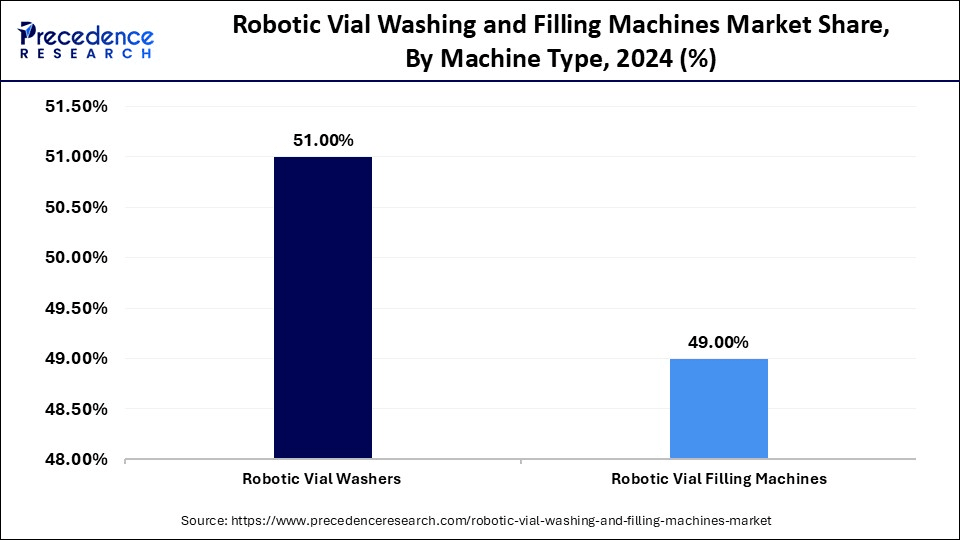
The robotic vial filling machines segment is expected to grow at the fastest CAGR during the forecast period. The segment growth is driven by their capability to manage high-precision, high-volume filling of injectable medications, particularly those used for chronic illnesses. These machines include vision systems that enhance precision and accuracy in filling by ensuring that each vial receives the correct dosage. The rising demand for injectable drugs, advancements in automation, and an increasing focus on regulatory compliance and sustainability further contribute to segmental growth.
Type Insights
What Made Standalone Washing Machines the Dominant Segment in the Robotic Vial Washing and Filling Machines Market in 2024?
The standalone washing machines segment dominated the market with a major revenue share in 2024 due to their higher productivity, accuracy, and adherence to rigorous standards like cGMP, which significantly boost vial washing and filling capacity. As the pharmaceutical industry mandates strict compliance with cGMP standards, robotic systems readily ensure product safety and quality. These machines reduce human error by providing repeatability and scalability to address increased production demands, particularly in the expanding pharmaceutical sector focusing on biologics and injectables.
The standalone filling machines segment is expected to expand at a significant CAGR in the upcoming period. The versatility, modular design, and cost-effectiveness of these machines make them suitable for large-scale pharmaceutical production. Standalone machines can be configured with modules for various applications, such as rinsing, sterilization, and drying, allowing tailored solutions for specific drug products and production scales. These machines also provide pharmaceutical manufacturers with the capability to customize washing and filling processes for different vial formats and production needs, making them a preferred option for small-volume parenteral production.
Application Insights
How Does the Vaccines Segment Dominate the Robotic Vial Washing and Filling Machines Market in 2024?
The vaccines segment dominated the market with a major revenue share in 2024. This is mainly due to the increased demand for vaccines, together with the rigorous quality and safety regulations. Vaccines often require high levels of sterility and precision for their safety and efficacy. Robotic systems minimize human intervention by minimizing the risk of contamination and ensuring product quality. The global demand for vaccines has been steadily increasing due to the growing concerns of emerging infectious diseases. The rising number of routine immunization programs that need higher production volumes further ensures the long-term growth of the segment.
The small molecule drugs segment is expected to grow at a significant CAGR during the forecast period. The growth of the segment is attributed to the increasing volume of small molecule drugs in development and the rising need for automation in their production. Various trends in the pharmaceutical industry, like the focus on personalized medicine and the development of tailored therapies, further drive segmental growth. Moreover, the increasing demand for injectable drugs, which are often formulated as small molecules, and the need for enhanced precision and sterility in their manufacturing support segmental growth.
End-User Insights
Why Did the Pharmaceutical & Biopharmaceutical Companies Segment Dominate the Market in 2024?
The pharmaceutical & biopharmaceutical companies segment dominated the market in 2024. This is primarily due to stringent regulatory requirements governed by frameworks such as ICH, USFDA, and cGMP, which demand strict cleaning and validation processes for vials. This segment's dominance is further reinforced due to the need for high precision and sterility, alongside an increasing demand for injectable medications. These companies benefit from the automation these machines provide, which boosts efficiency and reduces contamination risks, ensuring compliance with standards.
The CMOs & CDMOs segment is expected to grow at a considerable CAGR during the projection period as pharmaceutical and biotech companies are outsourcing their manufacturing processes to these specialized organizations. This trend is further driven by the pharma and biotech companies' focus on eliminating the significant capital expenditure on equipment and infrastructure while enhancing efficiency. Outsourcing manufacturing processes to these organizations enables pharma and biotech companies to focus more on core competencies like research and development. These systems also provide higher throughput and greater flexibility compared to traditional methods to handle a broader range of drug products and production volumes and meet the growing demand for efficient and high-quality drug production.
Robotic Vial Washing and Filling Machines Market Companies
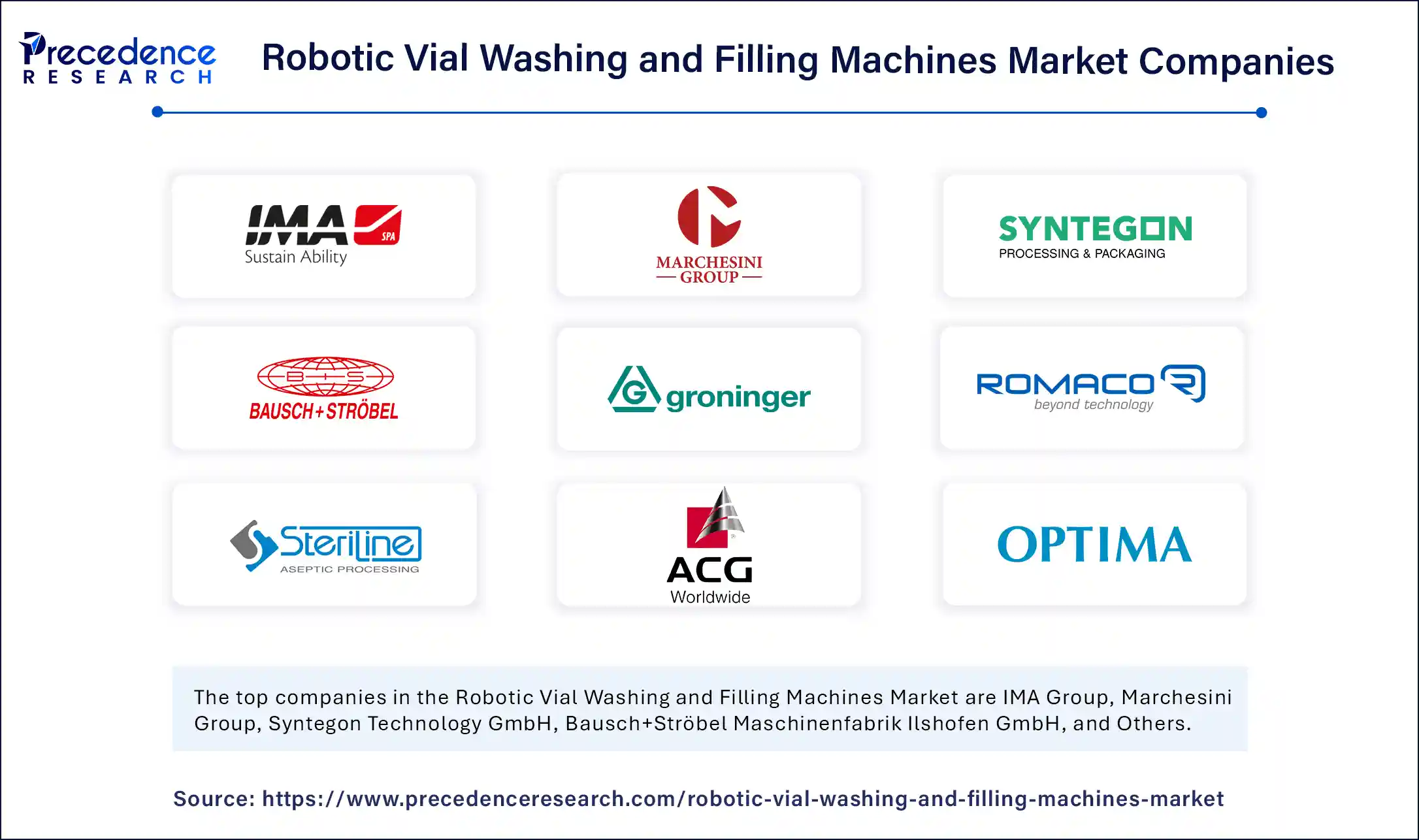
- IMA Group
- Marchesini Group
- Syntegon Technology GmbH
- Bausch+Ströbel Maschinenfabrik Ilshofen GmbH
- groninger & co. GmbH
- Romaco
- Steriline S.r.l.
- ACG Worldwide
- Optima Packaging Group
- Bosch Packaging Technology
- Seidenader Maschinenbau GmbH
- Schott AG
- Krones AG
- Cama Group
- Tetra Pak
Recent Developments
- In March 2025, Steriline showcased a Robotic Vial Filling Machine utilizing Planar Motor technology, a magnetically levitated transport system. This solution consists of a unique platform that levitates movers above a stainless surface, providing six degrees of precise motion and zero friction. The transport of containers from station to station in the filling and closing operation occurs without mechanical components, and the use of robotics for loading and unloading results in a highly flexible and clean platform.
(Source: https://pharmaceuticalmanufacturer.media) - In May 2024, Civica installed new high-value filling lines for essential medicines. A new isolator-integrated vial filling line and nest filling line enable the company to produce various forms of injectables based on needs.
(Source: https://www.healthcarepackaging.com)
Segments Covered in the Report
By Machine Type
- Robotic Vial Washers
- Rotary Washing Machines
- Linear Washing Machine
- External Washing Machines
- Robotic Vial Filling Machines
- Powder Filling Machines
- Modular Machines Filling Machines
By Type
- Standalone Washing Machines
- Standalone Filling Machines
- Integrated Washing and Filling Systems
By Application Type
- Vaccines
- Biologics
- Small Molecule Drugs
- Specialty Pharmaceuticals
By End-User
- Pharmaceutical & Biopharmaceuticals Companies
- Biotechnology Companies
- CMOs & CDMOs
- Research Laboratories
- Others (CROs etc.)
By Region
- North America
- Europe
- Asia-Pacific
- Latin America
- Middle East and Africa
For inquiries regarding discounts, bulk purchases, or customization requests, please contact us at sales@precedenceresearch.com
Frequently Asked Questions
Ask For Sample
No cookie-cutter, only authentic analysis – take the 1st step to become a Precedence Research client